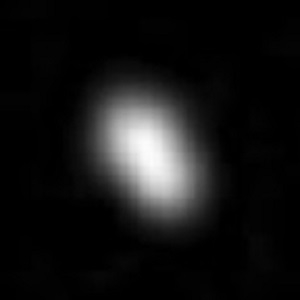Styx (moon)
| Styx | |
|---|---|

|
|
| Styx captured by the New Horizons spacecraft on July 13, 2015 | |
| Provisional or systematic name | S / 2012 (134340) 1 Pluto V. |
| Central body | Pluto |
| Properties of the orbit | |
| Major semi-axis | (42,000 ± 2,000) km |
| Periapsis | unknown |
| Apoapsis | unknown |
| eccentricity | ≈ 0 |
| Orbit inclination | ≈ 0 ° |
| Orbital time | (20.2 ± 0.1) d |
| Physical Properties | |
| Albedo | 0.5 |
| Medium diameter | approx. 7 km × 5 km |
| Dimensions | 7.5 x 10 15 kg |
| discovery | |
| Explorer |
Mark R. Showalter et al. |
| Date of discovery | July 11, 2012 |
Styx is the second closest and smallest of the five known moons of the dwarf planet Pluto .
Discovery and naming
On July 11, 2012, NASA announced the discovery of a fifth moon of Pluto , about a year after the discovery of the fourth moon, Kerberos . The Trabant was given the provisional designation S / 2012 (134340) 1. It was discovered during the search for possibly existing planetary rings in nine image series of the Wide Field Camera 3 of the Hubble Space Telescope recorded between June 26 and July 9, 2012 . The discovery was made by a team of astronomers led by Mark R. Showalter from the SETI Institute .
On July 2, 2013, the IAU announced that the moon was officially recognized as the fifth moon of Pluto and confirmed the proposed name Styx , after the river in Greek mythology, submitted by Showalter on the basis of an internet vote .
Track properties
The mean distance to Pluto is 42,000 km ± 2,000 km, so that the orbit lies between the already known moons Charon and Nix . Styx is close to a 1: 3 orbit resonance with Charon. The movement data measured so far indicate an almost circular, equatorial orbit. Further observations are necessary for a more precise orbit determination .
Physical Properties
Based on the New Horizons images , the diameter is estimated at 5 km × 7 km, which corresponds to an elongated and probably quite irregular body, analogous to other small moons of this size. Although Styx is the faintest object in the Pluto system, it has a very large albedo . Since this was not initially suspected, a significantly larger size of 10 to 25 km was assumed. At least the surface of Styx is probably made of ice.
exploration
Until early 2015, the moon only appeared on some of the Hubble Space Telescope images that could detect the moon. Surface details could not be seen on it. In mid-July 2015, the New Horizons spacecraft approached Pluto. In the immediate run-up, the orbits of all moons were determined very precisely by the space probe. In addition to detailed images of the dwarf planet and its largest moon Charon, images of Styx were also made; the first images have already been transmitted to earth. A more detailed evaluation of the data is still pending (October 2015). The James Webb Space Telescope will then be used for further observations and measurements of surface chemistry .
Web links
- IAUC 9253: New Satellite of (134340) Pluto: S / 2012 (134340) 1 (currently still subject to registration) July 12, 2012 (discovery)
- Space Telescope Science Institute: Hubble Discovers a Fifth Moon Orbiting Pluto .
- Tilmann Althaus: A fifth moon for Pluto , in ASTROnews of July 11, 2012.
- John Matson: Hubble telescope spots a 5th Plutonian satellite , article in Nature online July 12, 2012 (originally published in Scientific American )
- Wm. Robert Johnston: (134340) Pluto, Charon, Nix, and Hydra
Individual evidence
- ↑ IAU1303 News Release: Names for New Pluto Moon Accepted by the IAU After Public Vote , July 2, 2013.
- ↑ http://www.nasa.gov/nh/new-horizons-picks-up-styx
- ↑ P5 calls the earth , article in the daily newspaper of July 13, 2012
